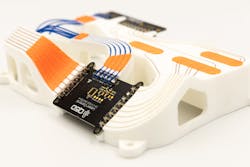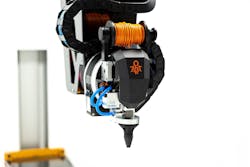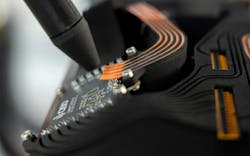Streamlining Wire Harness Manufacturing with a 5-axis Robot
In an era where streamlined manufacturing processes and cost efficiency drive success, UK-based Q5D is reshaping the future of industrial production with its CY1000 robot for automating wire harness manufacturing.
The company originated in 2020 as a spin-off from two manufacturing tech companies. Q5D leverages the expertise and intellectual property of an additive manufacturing company and a machinery manufacturer specializing in laser micro machining.
Although the underlying technology has been in existence for a longer period, the CY1000—the company’s first product—launched in April 2023. Designed to automatically add components, connections and conductors to products made of metal, ceramic or polymer, the machine’s development was inspired by the stagnation of the consumer 3D printing market and rapid growth observed in industrial manufacturing, according to Steve Bennington, CEO of Q5D.
“We saw that the industrial market was growing very fast,” he said. “A lot of additive manufacturing is just landfill at the end, it’s just bits of plastic, whereas if you could make it functional, you could add electrical conductors to it to make it so that it’s as a useful part of a product that we thought…would be marketable.”
This approach presented opportunities for reducing manufacturing costs and enhancing product quality compared to traditional handmade processes.
“We realized that the wiring harness world is probably the last part of the manufacturing world, which is still all or largely done by hand. …So, if you can…automate that, there are all sorts of potential benefits. …You’re taking out…a huge amount of labor—and it is an astonishing amount of labor that they use to make and install wiring harnesses,” he said.
READ MORE: Motion Control Components Benefit Robot Performance
How Does the CY1000 Work?
The CY1000 robot is designed with linear motors. Bennington said this is the same kind of technology that is used in rail guns or monorails and high-performance machine tools. “It is essentially a motor where the stator (innards) [is] rolled out flat,” he explained. “They are expensive but very fast and accurate. We are using a version with high-precision encoders to give us the precision that we need.”
The machine operates by depositing existing wire (insulated or uninsulated, coaxial or twisted pair) onto a surface using a robotic system. The machine ensures fast and accurate wire laying and termination, according to Bennington, with compatibility for a range of wire gauges up to 3 mm in diameter.
He said the machine’s design includes a five-axis platform capable of accommodating different wire deposition and termination end effectors. While additive manufacturing plays a minimal role in the process due to its time-consuming nature, Bennington noted that it is employed for specific tasks such as securing wires in place with a layer of polymer. “It’s almost all about the wire deposition,” he said.
Traditional wire harness manufacturing involves time-consuming tasks such as utilizing pin boards for wire layout and intricate connections, Bennington said, but this machine removes the need for elaborate wire routing and intricate connections by using wire traps and individual wire spaces. By creating a systematic and organized wiring layout, the CY1000 streamlines the process and eliminates requirements for additional standoffs and tie wraps, resulting in significant weight reduction and cost savings.
“For example, when we’re working in the aerospace sector, we tend to work mostly in the cabin,” he said. “We’re taking out something [like] 30% of the weight of the wiring harnesses, and that could be…5% to 10% weight of a business class seat overall…and that is all around taking out all of the stand-offs and tie wraps and all the other bits and pieces.”
Solving Manufacturing and Supply Chain Challenges
When the company introduced its robot, there was an overwhelming response from the automotive sector. The automotive industry faced significant challenges related to supply chain disruptions caused by the pandemic and issues with sourcing semiconductors, Bennington said.
The challenges, coupled with the transition to electric vehicles and the need for onshoring or “friendshoring” manufacturing processes to tackle skills shortages and rising labor costs, created the perfect storm for Q5D’s solution, he added.
Automakers saw the potential for cost savings, improved quality and increased automation in the manufacturing of wire harnesses, a labor-intensive process traditionally done by hand. “They were very receptive to new manufacturing methods,” he said.
While the automotive sector quickly embraced the CY1000, the company’s initial target customers included manufacturers of machine tools, consumer electronics and industrial electricals, Bennington said. Q5D is actively working with customers in these fields, establishing partnerships and exploring new projects.
In the consumer electronics realm, Q5D collaborated with makers of injection-molded parts, incorporating wire guides to prevent entanglement during assembly. The company has also brought its five-axis robot to aerospace applications. While collaborating with a customer in this space, Q5D worked with a composite part, an air intake and integrated printed electronics to attract heat, which enhanced versatility and automation.
By simplifying and automating processes with tools like the CY1000 robot, Bennington said manufacturers can achieve higher accuracy and reduce product failures.
READ MORE: Opportunities and Challenges for Fluid Power in Automation
Future Growth Potential for the 5-Axis Robot
Looking ahead, Bennington said the company has plans to introduce conductive ink end effectors, which will enable the incorporation of printed electronics on a larger scale. These end effectors, initially scheduled for release in late 2023, have been temporarily delayed due to overwhelming customer demand and the need to raise additional funds to accommodate the company’s growth, he said, adding that Q5D is committed to advancing its technological offerings and plans to ship the next generation of more focused and customer-centric machines by mid-2024.
As a young company, Q5D has focused on piloting machines and collaborating closely with customers. With an increasing demand for its solution, Bennington says the company is ramping up manufacturing capabilities and expanding its teams, including software development, product support and manufacturing engineering.
He mentioned working on a CAD/CAM product with Siemens NX. And as the company prepares to ship units to the U.S. and EU, it is also setting up subsidiaries in these regions to provide localized account management and service engineering teams.
Another part of the company’s growth plan includes catering to diverse customer requirements. The next generation of robots will be designed to address specific needs and preferences. Customer feedback and industry insights gathered from the current model have shaped the development of more focused solutions. “The next fleet of machines [is] going to be bigger,” Bennington said. For instance, “the automotive [industry] wants to get up to 2 by 4 m,” he said. To meet the demands, he said Q5D will modify the frame, incorporating its robust linear motors, while keeping other features unchanged.
While the current machine is designed with an open side for robotics access, the next-gen models will have conveyor access for seamless integration within automated manufacturing processes. Bennington said this flexibility will allow the machine to be utilized as a stand-alone unit or as part of a larger production line, depending on customer requirements.
“It’s interesting just to talk about these things conceptually, but it only really gels when you actually start to talk about exactly what it might be for,” he concluded.
Watch Power & Motion's video interviews with Bennington to learn more about the Q5D.
Part 1: Q5D Robot Benefits Automakers by Automating Wire Harness Production
Part 2: Q5D Looks to Expand Capabilities and Applications for Additive Manufacturing Robot
About the Author
Sharon Spielman
Technical Editor, Machine Design and Power & Motion
Sharon Spielman is a technical editor for Power & Motion and its affiliate publication Machine Design. As technical editor, her beat includes 3D printing/CAD; mechanical and motion systems, with an emphasis on pneumatics and linear motion; automation; robotics; and AR/VR.
Sharon has more than three decades of experience as a writer and editor for a range of B2B brands, including those that cover electrical design and manufacturing; interconnection technology; food and beverage manufacturing; process heating and cooling; finishing; and package converting.

Leaders relevant to this article:



